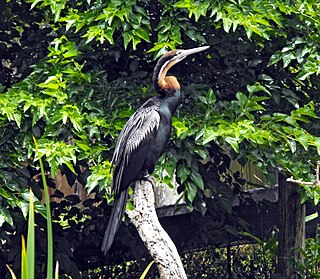
The darters, anhingas, or snakebirds are mainly tropical waterbirds in the family Anhingidae, which contains a single genus, Anhinga. There are four living species, three of which are very common and widespread while the fourth is rarer and classified as near-threatened by the IUCN. The term snakebird is usually used without any additions to signify whichever of the completely allopatric species occurs in any one region. It refers to their long thin neck, which has a snake-like appearance when they swim with their bodies submerged, or when mated pairs twist it during their bonding displays. "Darter" is used with a geographical term when referring to particular species. It alludes to their manner of procuring food, as they impale fishes with their thin, pointed beak. The American darter is more commonly known as the anhinga. It is sometimes called "water turkey" in the southern United States; though the anhinga is quite unrelated to the wild turkey, they are both large, blackish birds with long tails that are sometimes hunted for food.

The Pelagornithidae, commonly called pelagornithids, pseudodontorns, bony-toothed birds, false-toothed birds or pseudotooth birds, are a prehistoric family of large seabirds. Their fossil remains have been found all over the world in rocks dating between the Early Paleocene and the Pliocene-Pleistocene boundary.

Phocinae is a subfamily of Phocidae whose distribution is found in the seas surrounding the Holarctic, with the Baikal seal being the world's only freshwater species of pinniped. What distinguishes them from other phocid seals is the presence of well-developed claws on their front and back flippers. The Phocinae is divided into three extant tribes: Erignathini, Cystophorini, and Phocini. Members of both Erignathini and Cystophorini have 34 chromosomes, while species in the tribe Phocini have 32 chromosomes.

Ontocetus is an extinct genus of walrus, an aquatic carnivoran of the family Odobenidae, endemic to coastal regions of the southern North Sea and the southeastern coastal regions of the U.S. during the Miocene-Pleistocene. It lived from 13.6 mya—300,000 years ago, existing for approximately 13.3 million years .
Leptophoca is an extinct genus of earless seals from the North Atlantic realm.
Herpetocetus is a genus of cetotheriid mysticete in the subfamily Herpetocetinae.
Monotherium is an extinct genus of phocid belonging to the subfamily Monachinae. It is known from fossils found in the middle to late Miocene of Belgium.

Pliophoca is an extinct genus of seal in the family Phocidae.

Albicetus is a genus of stem-sperm whales that lived during the Miocene Epoch, around 15 million years ago, and was discovered in Santa Barbara, California in 1909. It was categorized for decades as belonging to a group of extinct walruses erroneously thought to be sperm whales. It was named Albicetus, meaning "white whale", is a reference to the leviathan in Herman Melville's classic 1851 novel Moby-Dick.
Nanophoca is an extinct genus of earless seals from the middle Miocene of Belgium.
Phocanella is an extinct genus of earless seals from the early Pliocene of Belgium and the US Eastern Seaboard.
Pontophoca is an extinct genus of earless seals from the middle-late Miocene of the eastern Paratethys basin and the North Sea.
Platyphoca is an extinct genus of earless seals from Neogene marine deposits in the North Sea basin.
Gryphoca is an extinct genus of earless seals from Neogene marine deposits in the North Sea basin.
Praepusa is an extinct genus of earless seals from Neogene marine deposits in Europe.
Homiphoca is an extinct genus of earless seals from the Pliocene of South Africa.
Afrophoca is an extinct genus of earless seal from Miocene-age marine deposits in Libya.
Callophoca is an extinct genus of earless seals from the late Miocene to early Pliocene of Belgium and the US Eastern Seaboard.
Frisiphoca is an extinct genus of phocid belonging to the subfamily Phocinae. It is known from fossils found in the late Miocene of Belgium.









